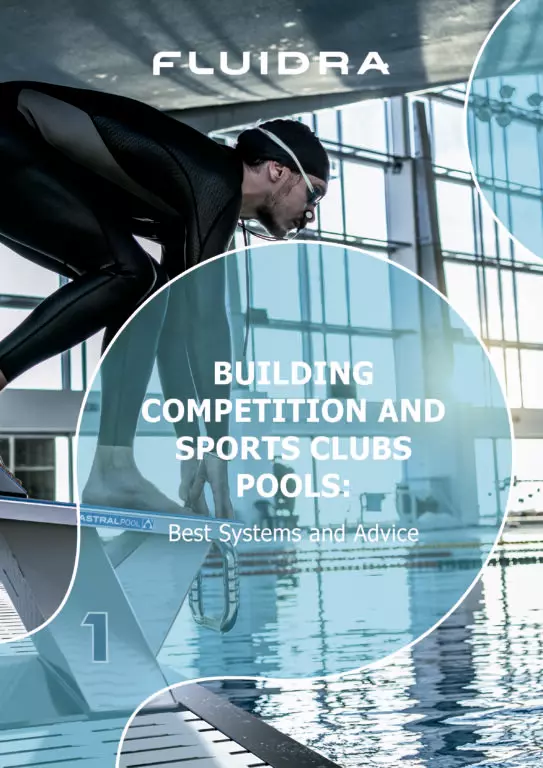
A lap pool (or a competition swimming pool) is one specifically designed to develop competitive sports. Such activities are not recreational but focused on healthy goals related to training and physical activities.
Some of the most common activities on training swimming pools include:
- Individual free-swimming
- Collective swimming lessons
- Physical rehabilitation sessions
- Muscle training sessions
Hotels
These swimming pools are specifically designed so that guests can swim and relax, during their holidays or after a long day at work. These can be found both indoors and outdoors.
Sport clubs
These are designed for swimming lessons or training in mind. In other words, they are planned for health, learning and training purposes.
Municipal swimming pools
These swimming pools are designed for training or taking swimming lessons. Being public goods, they must be adapted so that users from different ages and socioeconomic backgrounds can have access to them. This means these are installations that should welcome everyone in the population.
Wellness spaces
These include those swimming pools designed for muscle relaxation in a therapeutic or health-related context. It’s advisable for muscles to exercise before receiving any treatment.
Some of the most common accessories that can be found on a lap pool include:
Starting blocks or podiums
These are elevated structures from which swimmers can jump into water and constitute the starting point for many competitions. They are made from AISI-316 stainless steel and include an adjustable platform made of polyester and anti-slippery FV to avoid falls and slips
Lane lines
These are essential elements to separate the different lanes inside the pool during training sessions or competitions. They are made using flow-through technology, a stainless steel wire that measures 6 mm, tensioners, dampers and a claw.
Signs
These offer users important information during their training sessions and competitions. For instance, for those practicing backstroke swimming, it’s essential to present them with a warning signal when they approach the pool’s edge (typically, these signs indicate appear when they’re 5 metres away from the edge).
A lap pool can be constructed using different solutions:
SkyPool
These are prefabricated swimming pool panels that can be adapted both to new and old infrastructure. These panels are easily held and assembled, which means both elevated and buried swimming pools can be constructed in record times.
Made from galvanized steel, these panels are hot-dip in zinc, which guarantees their safety and longevity.
Skypool renovation panels
These present the right solution for any old infrastructure that needs an update in order to adjust to new standards.
They are easily and quickly installed, with no need to tear down the whole pool. Installing these galvanized steel panels means only the pool’s edge must be broken down, while also installing a new overflow channel. These are available in ceramic and non-ceramic finishes, including integrated drain outlets. This constitutes the most economic solution in order to give a new life to an old swimming pool.
Bluespring
The Laghetto Bluespring’s modular structure allows for the construction of elegant and personal swimming pools, which present geometric patterns and exceptional quality and longevity features. It’s perimeter, double-wall, self-supporting structure, which includes an overflow channel and a compensation tank, doesn’t require a retaining wall or earth fillings. Masonry works are thus reduced to a minimum.
Inox Pool
Made from stainless steel, Fluidra’s training swimming pools consist of a light and sustainable structure. They adapt elegantly, simply and hygienically to each space, which makes them the perfect solution for wellness spaces or boutique hotels.
Even if each lap pool presents its own characteristics and needs, there are some design recommendations that should be taken into account regarding these installations:
- Rectangular geometry. This is the most advisable shape for training swimming pools, as it makes it easy to use and makes the most of space.
- Standardized sizes. Although there are different size options, the most common are 25 m x 12,5 m o de 25 m x 16,5 m.
- Temperature. As per World Aquatics (former FINA) recommendation, water’s temperature must oscillate between 25 and 28 ºC.
- Depth. For occasional or amateur swimmers, a depth of 1.4 metres is advisable. For professional swimmers, depth must be at least 1.8 metres.
- Recirculation time. While this depends on local rules, it typically oscillates between 2 and 4 hours.
- Water treatment. An UV water treatment system or a salt chlorinator are recommended. Both reduce the presence of chlorine-related subproducts in water to a minimum, which increase swimmer’s wellness and reduce eye soreness and potential mucous irritation.
- Surface finishes. The most advisable and efficient material is PVC, specially in the case of panel systems.
- Water recirculation. An overflowing system all around the pool’s edge is the most efficient method.
- Construction system. The prefabricated panel modular system made from steel allows swimming pools to follow World Aquatics regulations in terms of sizes, as well as the rest of swimming federations. The Skypool or Skypool Renovation panels are the best option for those swimming pools aiming to meet World Aquatics standards. Bluespring or Inox Pool are the best for those that don’t need to comply with these standards.
- Pool accessories: it’s advisable for pools to use lane lines, podiums, backstroke signs and false-start indicators.
- Regarding the different regulations, a customized designed is fundamental to guarantee each project complies with new prescriptive technical rules.
These recommendations ensure the design and construction of training swimming pools follows the highest quality standards for long-lasting facilities.
